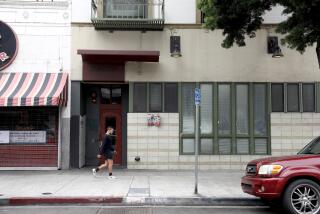Developer Is Still Going Strong at 90
- Share via
Fred W. Marlow turned 90 last week, but his ideas about sheltering the underprivileged are the same as they were 45 years ago, when he opined on a Los Angeles radio station that all housing should be constructed by free enterprise.
Marlow still runs his Marlow & Co. development company with the help of his son Hobbs. “Every New Year’s, I make a resolution to only work Monday, Wednesday and Friday, and every Jan. 2 I violate the resolution,” he said. He goes to his office every day and works from 10 a.m. to 4 p.m., but he looks at it as fun, though times have changed, in some ways, he agrees.
“I was always opposed to government housing,” he said a few days ago in his Brentwood offices, remembering the radio talk he gave as president of the Los Angeles chapter of the National Assn. of Home Builders, “but government can play a part by insuring the loans.”
Marlow was talking about a role of the Federal Housing Administration, which he represented as its first director of the Southern California District for four years, starting in 1934.
“FHA was a good program, and it still is,” he said, despite FHA’s recent troubles stemming from depressed economic conditions in such states as Texas and Colorado. (HUD or the Department of Housing and Urban Development, parent of FHA, had to take possession of about 64,000 homes because the owners defaulted on FHA-guaranteed mortgages.)
“The FHA has done more for housing than any other government program, and it has had tremendous results,” Marlow said, though critics might say the FHA has done nothing for the homeless. (The Berkeley-based National Housing Law Project, a public interest law firm, recently filed a lawsuit contending that HUD is required by law to survey its inventory to see if some of the houses, taken through foreclosure, can be used to house the homeless.)
“Look at those houses in Westchester. First, because of FHA-guaranteed mortgages, war workers lived there. Then the houses were occupied by veterans.”
Not long after leaving the FHA, Marlow teamed up with the late Fritz B. Burns in developing Westchester, Baldwin Hills and the Hollywood Riviera, just north of Palos Verdes.
“But our biggest project together was Westchester,” Marlow recalled.
They bought 150 acres in what is now known as Westchester from Security Bank in 1941. Shortly after, Marlow was sitting in his Pacific Palisades patio when he heard that Pearl Harbor was bombed.
“I thought, financially, this will kill me, but--in fact--it made us,” he said, “because Westchester’s location (near the airport) enabled us to build housing for war workers, and because of that, we could get building materials that we couldn’t get otherwise.”
They built 2,000, two- and three-bedroom houses, which sold then for $4,950 and $5,400.
Mentioning dollar amounts that are laughable today reminded Marlow that he only made $6,000 a year when he joined the FHA soon after it was created to fuel home building after the Depression.
Then he thought of this:
“When the FHA came in, banks were loaning at 8 1/2% to 9%. I came in and offered (through the FHA) to guarantee loans at 5% for 20 years, and the bankers wouldn’t go for it at first, because there was no such thing as a 20-year mortgage in 1934. All loans had to be refinanced after three years or the homeowners would lose their houses.”
By 1934, Marlow was an MIT and West Point graduate who personally had reduced welfare rolls from 65,000 to 37,000 people through a temporary position he held with a federal government organization known as the Civil Works Administration.
He was only 35 when he became an FHA director. “So I looked pretty young to those old bankers,” he said, “and they didn’t know anything about the FHA.”
It took a few months, but the bankers finally saw the loan-guarantee advantages, and the rest is FHA and Marlow history.
While he has always focused on buying large parcels and subdividing them, his son buys lots at $600,000 to $700,000 each and builds houses there that sell for $2 million and more.
“He doesn’t have to do too many of those a year to do as well as I with 100 houses at a much lower price,” the elder Marlow said.
More to Read
Sign up for Essential California
The most important California stories and recommendations in your inbox every morning.
You may occasionally receive promotional content from the Los Angeles Times.






